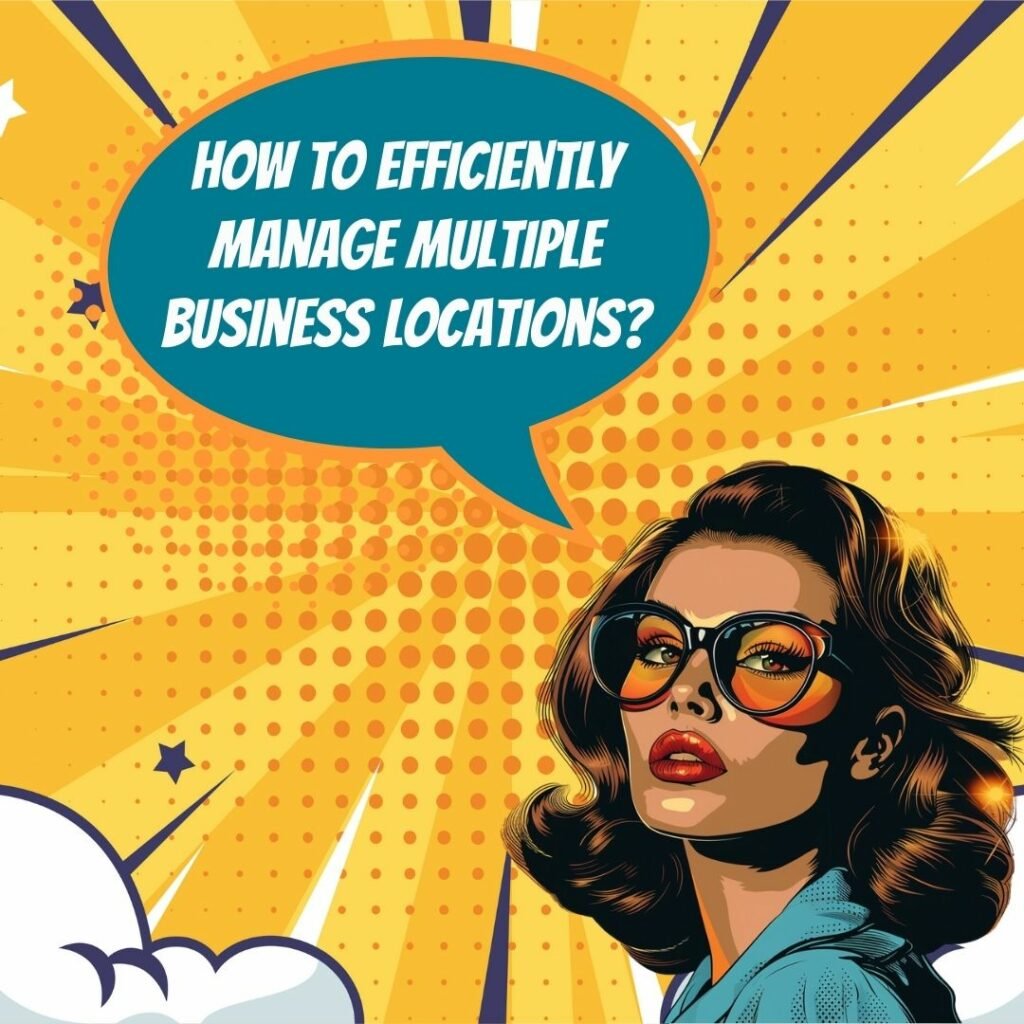Key Takeaways
✅ Standardize Processes Across Locations: Achieving a harmonious operation across all your business locations is not just beneficial; it's essential. By standardizing processes, businesses can ensure a unified brand experience for customers and establish a smooth workflow for employees, reducing frustration and errors. Statistics show that companies with standardized operations see a reduction in operating costs by up to 15%. Implementing uniform practices in areas such as operations, employee training, and technology use is crucial for maintaining quality and efficiency.
✅ Effective Communication and Collaboration: In the digital age, the ability to communicate and collaborate effectively is more important than ever, especially when managing multiple locations. Effective communication fosters a sense of community and purpose among employees, which can significantly enhance productivity and job satisfaction. Companies that excel in communication and collaboration are 4.5 times more likely to retain the best employees. Regular meetings, clear communication policies, and the right technology tools are keys to achieving this.
✅ Clear Objectives and Adaptability: For businesses with multiple branches, having clear objectives that are tailored to each location's strengths and market demands can drive significant improvements in performance and customer satisfaction. Moreover, adaptability in strategies and operations allows a business to quickly respond to market changes and challenges, ensuring long-term sustainability. Organizations that adapt their goals based on market feedback tend to grow 3.5 times faster than their competitors.
 Introduction
Introduction
Have you ever wondered what the secret sauce is behind managing successful multiple business locations? It's not just about duplicating what works in one place and pasting it in another. The art of managing multiple locations is like conducting a symphony; every part needs to harmonize perfectly while still allowing for local solos.
In today’s dynamic market, simply opening new locations and expecting them to thrive on their own is a strategy doomed to fail. Businesses face various hurdles such as maintaining consistent quality, fostering effective communication, and ensuring all branches align with the central brand identity. However, with the right strategies, businesses can turn these challenges into opportunities, maximizing revenue and ROI across all locations.
This article peels back the layers on modern trends, innovative perspectives, and actionable insights into managing multiple business locations successfully. You’re not just about to learn how to keep your brand consistent across all fronts; you’re about to discover how to make each location a local powerhouse in its own right. Stay tuned as we dive deep into strategies that promise not just to enlighten but to empower your expansion journey.
Top Statistics
| Statistics | Insight |
|---|---|
| Business Expansion Strategy: Exploring population indicators, migration and income patterns, and neighborhood recovery indicators is crucial when creating stores in new locations. | This insight illuminates the essential groundwork needed for effective expansion. Knowing where to grow is just as important as knowing how to grow. |
| Marketing Automation: Automating marketing reporting for multi-location businesses can significantly reduce the complexity and manual effort involved in reporting at different levels. | Simplifying the reporting process through automation can save valuable time and resources, allowing businesses to focus more on strategy and less on tedious tasks. |
| Google My Business: Using Google Data Studio, businesses can track multiple Google My Business locations in a single dashboard, providing a comprehensive view of local business listing stats. | Having a bird’s-eye view of all your locations through an easily accessible dashboard is invaluable for strategic decision-making and understanding your business’ local footprint. |
| Customer Service: Comparing location data helps businesses measure progress, identify trends, and optimize resource allocation across multiple locations. | This highlights the importance of not just collecting data, but actively using it to enhance customer service and operational efficiency. |
Recognizing the Challenges
Running a business across multiple locations isn't just about opening new offices or stores; it's about facing an array of hurdles head-on. Communication barriers, logistics headaches, and keeping a unified company culture become day-to-day issues. The challenge here is to maintain the essence of your brand while efficiently managing diversity in operations and keeping every team member on the same page. Especially in today's world, where technology integration can either be a solution or add to the complexity, ensuring smooth operation across distances is crucial. Recognizing these challenges is the first step to crafting strategies that ensure each wing of your business flies in harmony with the others.
Establishing Clear Objectives and Functions
Each location of your business is unique, with its own set of strengths and opportunities that it brings to the table. Understanding and leveraging these qualities can set you apart from competitors. It's critical to define clear objectives and pinpoint the role of each office in achieving the overarching goals of your company. This specificity not only streamirezjinfo.wikipedia. lines indexing what success looks like for each site but also motivates teams by clarifying their contributions toward big-picture outcomes. A tailored approach ensures that the collective effort of multiple locations propels the business forward.
Standardizing Processes and Communication
To avoid falling into the chaos of disjointed operations, standardizing processes is a lifeline. Whether it's the way you manage inventory, handle customer service, or conduct meetings, consistency lays the foundation for efficiency. Implementing universal procedures, supported by technology that bridges the gap between locations, like office mapping and collaborative software, keeps everyone aligned. Moreover, a detailed communication plan, specifying when and how each team should connect, brings clarity and accountability, ensuring that all offices work in sync rather than isolation.
Fostering Collaboration and Consistency
Encouraging a culture of collaboration among different locations prevents the formation of operational silos. It's about creating a shared space, virtually or otherwise, where ideas can freely flow, and solutions can be developed collectively. Frequent, proactive visits by leadership and the implementation of a culture that prizes the open exchange of information supercharge this synergy. It champions a consistent experience not just for customers but for employees, reinforcing the idea that, despite the geographical spread, they are all part of one team, working towards a single goal.
Optimizing Online Presence
In the digital age, a cohesive online identity is non-negotiable. For businesses spread across various locations, this means establishing a centralized information hub and managing each site's digital footprint meticulously. Updating local listings, responding to reviews, and optimizing for local SEO ensure that customers can find and connect with your nearest location effortlessly. The digital face of your business should reflect its physical presence accurately, inviting interaction and building trust among local communities.
Continuous Improvement and Adaptation
The landscape of multi-location management is continuously evolving, driven by changes in technology, market trends, and consumer behavior. Regular updates to your strategy and tools ensure that your business remains agile, equipped to address the unique demands of each location. Leveraging analytics allows for targeted improvements, while encouraging local managers to actively contribute to their online presence ensures that your business stays relevant and responsive. The willingness to adapt, to embrace new tools and methodologies, is what keeps a multi-location business at the forefront of efficiency and growth.
Managing multiple business locations is an intricate dance of strategy, technology, and human touch. The businesses that flourish are the ones that recognize the challenges, establish clear objectives, standardize their operations, foster collaboration, optimize their online presence, and continuously adapt to the changing environment. With these strategies in hand, the complex web of multi-location management not only becomes manageable but a driving force behind the business's success.
AI Marketing Engineers Recommendation
Recommendation 1: Utilize Data Analytics for Localized Marketing Strategies: Leverage data analytics to gather insights into the local preferences and buying behaviors at each business location. This involves using advanced tools to analyze customer interactions, sales patterns, and market trends specific to each location. According to a report by McKinsey, companies that put data at the center of their marketing and sales decisions improve their marketing return on investment (MROI) by 15-20%. By tailoring your marketing efforts to align with local dynamics, you can significantly increase engagement and drive higher sales. The key here is to not treat every market the same but to customize your approach based on actionable data.
Recommendation 2: Implement Integrated Marketing Communications Across Locations: With the rise of omnichannel marketing, creating a seamless customer experience across all touchpoints is more important than ever. This means synchronizing your marketing messages across multiple business locations while still allowing for local customization. A recent survey by the Harvard Business Review found that 73% of shoppers use multiple channels during their shopping journey. By ensuring your brand's message is consistent yet adaptable to local nuances, you can create a more cohesive brand experience that resonates with a wider audience. Employing an integrated approach helps in reinforcing your brand’s message, making it more memorable and effective.
Recommendation 3: Adopt Location-based Marketing Technologies: Embrace location-based marketing technologies such as geofencing, beacons, and localized SEO to attract customers to individual store locations. For instance, geofencing allows businesses to send targeted advertisements to a smartphone user within a specific geographic area. According to a report by Factual, over 80% of marketers believe location-based marketing boosts customer engagement, customer loyalty, and overall sales. These technologies enable businesses to deliver personalized offers and content to potential customers nearby, directly influencing foot traffic and sales. Using these tools effectively can bridge the gap between online engagement and physical store visits, providing a tangible uplift in customer interactions and conversions.
Conclusion
In the tapestry of today's dynamic business environment, managing multiple business locations emerges not just as a strategy, but as a necessity for growth and expansion. The journey is fraught with challenges, from maintaining seamless communication across different geographies to ensuring a unified corporate culture. Yet, the rewards of effectively overcoming these hurdles are manifold, leading to enhanced productivity, a stronger brand image, and ultimately, an improved bottom line.
At the heart of this adventure, the strategies outlined — from establishing clear objectives for every branch to the standardization of processes and fostering collaboration — serve as your compass. They guide you through the labyrinth of logistical complexities and the nuances of local market dynamics. The emphasis on optimizing online presence cannot be understated, as it plays a pivotal role in the digital age by connecting all the dots between locations, making each one visible and vibrant in the virtual world.
As we reflect on these insights, remember that the goal isn't just about managing; it's about thriving. It requires a continuous effort in improvement and adaptation, leveraging data and feedback, to sculpt strategies that resonate with local flavors while preserving the essence of the brand. The call to action, then, is not just to manage, but to innovate, anticipate, and excel.
In a world where change is constant, those who adopt a proactive stance in managing multiple locations—regularly refining and adapting their strategies—will not only navigate the complexities of today but will also pave the way for success in the future.
FAQs
Question 1: What are the key challenges in managing multiple business locations?
Answer: The main hurdles include ensuring uniform operations, keeping up communication, and handling resources at different sites.
Question 2: How do I know if I'm ready to expand to multiple locations?
Answer: Look at your cash flow, profit, financial backing, your team's reliability, and product or service demand. Make sure your current business is doing well and that you have a strategy for the new spot.
Question 3: What are the essentials for managing multiple locations?
Answer: Organize operations, set up good communication, keep the company culture alive, use technology, and have a strong management crew.
Question 4: How do I keep things consistent across different locations?
Answer: Standardize procedures, use cloud software, and have a solid communication infrastructure for consistency and efficiency.
Question 5: How do I manage communication across multiple locations?
Answer: Hold regular meetings, use video calls, and have a company-wide communication platform to keep everyone in the loop and connected.
Question 6: What are the legal things to think about for multiple locations?
Answer: Follow local laws and rules, look into intellectual property matters, and talk to a lawyer to make sure everything's set up right and compliant.
Question 7: How do I decide what to focus on when managing multiple locations?
Answer: Visit each location regularly, delegate tasks, and prioritize urgent matters to give every place the attention it needs.
Question 8: How do I handle different markets and people?
Answer: Customize your offerings for local folks, research the market, and adjust your marketing plans for each area.
Question 9: What tech do I need to manage multiple locations?
Answer: Get cloud-based software for sales, timekeeping, managing projects, keeping track of stock, teamwork, bookkeeping, and customer management to make operations smoother and more efficient.
Academic References
- Kaplan, R.S. & Norton, D.P. (1996). Using the Balanced Scorecard as a Strategic Management System. Harvard Business Review, January-February, 75-85. This article introduces the Balanced Scorecard, a tool for managers to align activities to the vision and strategy of the organization, improve internal and external communications, and monitor organization performance against strategic goals.
- Porter, M.E. (1980). Competitive Strategy: Techniques for Analyzing Industries and Competitors. New York: Free Press. Porter's seminal work outlines how strategies can be created to gain competitive advantage in various industry environments, including how to manage and expand multiple business locations.
- Chatterjee, S. & Wernerfelt, B. (1991). The Link Between Resources and Type of Diversification: Theory and Evidence. Strategic Management Journal, 12(1), 33-48. This study provides insights on how businesses can effectively manage multiple locations by leveraging their existing resources and capabilities.
- Hitt, M.A., Ireland, R.D., & Hoskisson, R.E. (2017). Strategic Management: Concepts and Cases: Competitiveness and Globalization. Cengage Learning. This book offers a comprehensive view on strategic management, including managing multiple business locations with an emphasis on leadership, technology, and client satisfaction.
- Pan, Y. & Zinkhan, G.M. (2006). Determinants of Retail Patronage: A Meta-Analytical Perspective. Journal of Retailing, 82(3), 229-243. Discusses how understanding the unique needs of clients in different locations is vital for ensuring customer satisfaction and loyalty, which is essential for businesses operating in multiple locations.
- Gibson, V.A. (2003). Flexible Working Needs Flexible Space?: Towards an Alternative Workplace Strategy. Journal of Property Investment & Finance, 21(1), 12-22. Highlights the importance of technology and flexible workspaces in managing productivity across multiple business locations.
- Varadarajan, R. & Yadav, M.S. (2002). Marketing Strategy and the Internet: An Organizing Framework. Journal of the Academy of Marketing Science, 30(4), 296-312. This article emphasises on the significance of digital tools and local SEO strategies for successful online visibility and management of multiple business locations.












